Alex reports from fire zone, wildfire smoke, climate plus extreme flooding rains in Europe/World. Then replay speeches by Canadian fire guru Dr. Michael Flannigan, plus protecting your health from wildfire smoke, with Canadian medical doctor Michael Brauer.
Listen to/download this Radio Ecoshock show in CD Quality (57 MB) or Lo-Fi (17 MB)
Graphic by Kevin Paulsen “Fire Kneeling Among the Trees” https://www.facebook.com/kevin.paulsen
As the world slides into Hellish landscapes, my studio lost contact with the world. The nearby South Okanagan fire burned through the fiber optic cable supplying Internet and Television to a string of small towns east of Anarchist Mountain. We were cut off for 6 days by wildfires. Unplanned and unplugged. Maybe I needed that. Summer is holiday time, or it used to be.
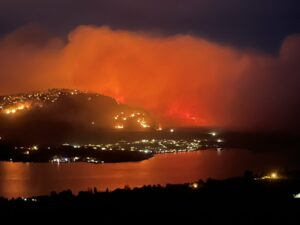
NK’Mip Fire above Osoyoos BC Canada July 2021, Courtesy Dylan Galeas
The five week extreme heat wave – and no significant rain since April – just waits for a bolt of lightning, car accident or stupid humans to erupt in massive fire storms roaring across forests, ranches, and homes, licking at the edges of some towns, while burning others down to a litter of concrete blocks and twisted metal.
Last week’s Radio Ecoshock show was uploaded to the networks through my wife’s cell phone, after driving half an hour closer to the fire zone, in fact, to the Evacuation Alert border. The show must go on.
Obviously the rest of the world is not on fire like the West Coast of North America. Climate change is like that old story of the blind man and the elephant. Each reports on the part of the animal they encounter.
This past week our European listeners want to know more about flooding, and the crazy extreme rainfall events striking again and again. A few London Tube stations filled up of course, but streets of floating cars is unusual. The rainy British capital expects lots of rain, but not that much that fast.
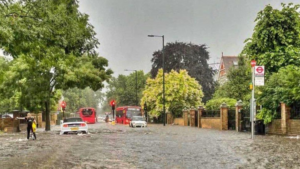
Streets of London flood July 2021 in extreme rainfall event. BBC photo.
Judging from news footage, it looks like older cities in Northern Europe were the most severely damaged by flooding. Some were established in the Middle Ages. In Belgium and Germany scores of towns flooded. The worst in Germany killed at least 130 people with dozens more still missing. Salzburg Austria got extreme rainfall and strange floods.
Extreme rainfall events are popping up all over the world. When more than a year’s worth of rain flooded the Holy City of Mecca some worshippers were thrilled, seeing the waters as a sign of God’s forgiveness. Don’t forget in July New York City experienced floods, including in the subway system, so did Detroit.
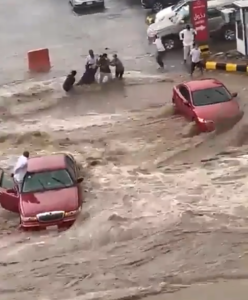
Weird floods Mecca, Saudi Arabia April 27, 2021.
It’s hard to classify the floods in Pakistan’s capital Islamabad on July 28, 2021 and the key Indian city of Mumbai. They too flooded out with near record rains. But that came along with the annual Monsoons, the storms that bring essential rains to India and Pakistan. Was this just a strong Monsoon? It may take some years for science to sort that out. The world’s largest refugee camp in Bangladesh flooded too. Flash floods killed hundreds of people in the last week of July in Afghanistan.
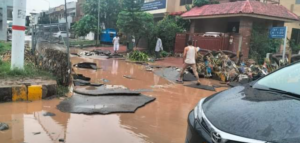
Streets wrecked in Islamabad July 28, 2021 by sudden “cloudburst” more than 100 mm. rain in some areas. Neighboring Iran also affected.
Some Chinese officials and media felt the same about the floods in Henan Province. You probably saw video of commuters up to their neck in water in subway cars. A year’s worth of water fell on the city of Zhenzhou in 72 hours. The authorities say the Yellow River always floods, so maybe that was not caused by climate change. My point is: the weather is going more and more into extremes which have been predicted for years on this show. For the West it’s drought and fire. Others get extreme rain or snow.
We know the atmosphere holds 7% more water vapor for every degree of warming. In the great global cycle, more water gets sucked out of the hot lands, making them drier, and falls elsewhere. Most of it goes into the ocean, which is changing marine chemistry, adding a fresh water layer near the surface. The rest has to come down somewhere.
But the two sides of extreme weather are related in multiple ways. Obviously, they are both fires and extreme rainfall events are driven by a hotter planet. Whether you get heat and fire or water seems to depend on two key factors. The main one: where has the famous Jet Stream stalled? In the Northern Hemisphere, the Jet Stream used to reliably flow fairly straight across continents, from West to East, as the world turns.
Scientists tell us the speed of the Jet Stream is determined by the temperature difference between the equator and the Poles. Now that the Arctic is about 18 degrees C hotter than normal much of the time, there is less difference, and thus less power to the Jet Stream. As a consequence, the Jet Stream now has large waves running from North to South and back. These waves can park over part of a continent, hold whatever weather is below. A stalled wave just caused a “heat dome” over Western North America, resulting in record heat, drought, and fires.
A recent map from NASA shows there were 5 heat waves active in the Northern Hemisphere in late June, early July. That is unusual to say the least. Number One is over the center of North America. The second straddles from Greenland, across Iceland to Northern Scotland. Number 3 hovers over central North Siberia but stretches down into the Middle East. The fourth is over far Eastern Siberia, and may explain why it has been a sweltering 34 degrees C during the Olympic games in Japan. Number 5 is over Alaska and Canada’s Yukon.
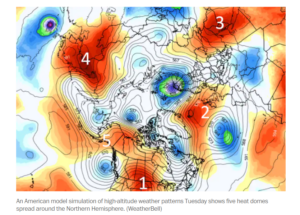
Map based on satellite data, created by WeatherBell, via the Washington Post. There are a few small cold pockets in between the big heat waves. Of course all this has changed by now.
Meanwhile there have been freak snow storms in Brazil, like in São Francisco de Paula, a region well north of Uruguay. It doesn’t snow there. And it snowed in the desert of South Africa, where lions left footprints in the snow. Highly unusual weather. In a conversation on this show, I asked Paul why Arctic cold was being pushed down into the States and Europe. He suspects Earth has a certain quantity of heat and cold at any time – so the cold has to go somewhere.
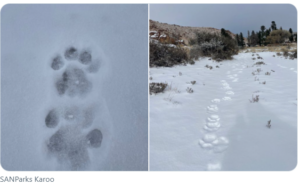
Outside my studio I can no longer see the nearby hill. Thick smoke is rolling in from wildfires further East, and from Washington State. You can find smoke maps from space showing smoke billowing across all of North America. New York City had off-the-charts dangerous air quality and low visibility for several days because of the fires. More people die when that happens. Medical statistics show it plainly. Smoking is bad for your lungs, from cancer, car exhaust or forest fires.
Some smoke rises in pyrocumulus clouds – giant billowing clouds cause by the intense fire itself. That blows around the Northern Hemisphere – but does not reach the Southern Hemisphere experts say. We have a situation with at least 7% more water vapor in the atmosphere. To have rain, or snow, that vapor needs to condense on nuclei of other matter, like dust or smoke. It seems common sense that smoke from vast wildfires in one part of the world could seed clouds over Europe and other places, stimulating or at least making possible more extreme rainfall events.
WHO OWNS THE RAIN?
Some humans are trying to do just that. The United Arab Emirates claims their national cloud-seeding system caused torrential rains there, out of season and with heat near 50 degrees C. As reported July 27, 2021 by Marimi Kishimoto and Jun Suzuki, China is testing their weather modification drone aircraft called Ganlin-1. China hopes to produce artificial rains over 60% of the country by 2025.
It’s called geoengineering, this time hoping to take advantage of the extra water in the atmosphere provided by climate change. China’s neighbors are worried. Nobody knows what impacts commandeering rain will have on nature’s animals and plants, not to mention cloud formation and weather in other countries. Rain control is already starting to happen.
FIRES – NOT COVID – DETERMINED CLIMATE THIS YEAR
You have heard of a slight drop in emissions in some countries due to COVID-19 lockdowns. A new study by the US National Center for Atmospheric Research finds wildfire smoke had a greater impact on global warming in 2020 than the pandemic.
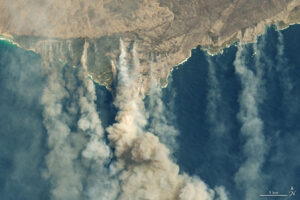
An image from NASA’s Landsat 8 satellite shows smoke billowing from major fires on Australia’s Kangaroo Island in early 2020. Credit: NCAR & UCAR
Paradoxically, the COVID lockdowns actually warmed the planet a little, rather than cooled it. With fewer cars on the road, less industry operating, the skies became clearer letting in more direct sunlight to heat the surface. But that impact was less than what wildfires do. It’s all very strange, and a bit difficult. We usually think fires cool the planet, and they can in the short-term. The scientists found, quoting their press release:
“the Australian bushfires cooled the Southern Hemisphere to such an extent that they lowered Earth’s average surface temperatures. This is because sulfates and other smoke particles interact with clouds to make their droplets smaller and reflect more incoming solar radiation back to space, reducing the absorption of sunlight at the surface.”
Scientist John Fasullo also wonders if wildfire smoke could impact the giant weather-making ocean currents El Nino and La Nina. After smoke from the Australian wildfires of 2019, scientists tracked tropical thunderstorms displaced further north than usual. There is a lot we do not know. In a way, the wildfire smoke is similar to the impact of volcano eruptions – and to the particles geoengineers hope to release trying to cool the planet. Would those experiments also displace weather systems and life-giving rain?
BREAKING DOWN IN THE HEAT
Meanwhile, power systems all over the world are under stress due to climate change. Extremely hot temperatures and drought have led to blackouts in cities across the Middle East, from Khuzestan through Tehran. That means no air-conditioning or fans for millions of people as heat pushes toward 50 degrees C, which is 122 degrees Fahrenheit.
California has repeatedly asked customers and industries to reduce their power consumption by about 25% or face rolling blackouts. As before, some power companies had to shut down their grid system proactively to prevent causing more deadly fires. In other places there is not enough water behind dams to run electric generating stations. You have to see a photo of what was Lake Oroville California. Now it is a rock gulch. Lost cars and bodies have emerged out of the bottoms of lakes and rivers across the West.
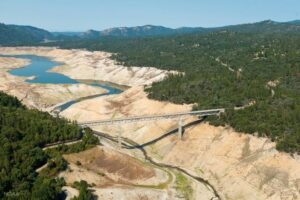
Here is a fact new to me: wildfire smoke can also reduce power on the electric grid. An article in the Los Angeles Times July 12th, says “a power line that’s part of the California-Oregon Intertie was knocked out by the fire. The heavy smoke acted as a conductor, interfering with the electric current.” end quote. The state of California suddenly had to scramble for 4,000 megawatts more imported energy to replace the smoke loss. Who knew?
A journal article from scientists in Nevada found wildfire smoke can also increase susceptibility to COVID-19. The numbers from Reno Nevada show this increase when the air is smoky.
Many municipalities have declared water emergencies. Residents are expected to let their lawns die to preserve enough drinking water. I expect the new and final stage soon, where even watering a garden is forbidden with a fine. However, we captured 500 gallons of rainwater from our roof back in April. So we can at least keep our fruit trees and key food gardens alive until Fall.
THE VIRUS AND CLIMATE ACTION
Meanwhile the Delta Variant of COVID virus is sweeping the world, literally sweeping the world. China declared the new Nanjing outbreak the largest since Wuhan. Japan goes into great emergencies by the week. Parts of Australia are in lockdown. America recorded over 60,000 new cases a day this week. I won’t list them all.
Governments are reacting quite differently. We all know that big changes and big spending seem possible during an emergency. That has not happened yet during the climate emergency. From the climate perspective, we see chilling examples of possible future in the COVID response. Some anti-Vaccine people in the Southern States are asking for the vaccine as they lay in intensive care, struggling to breath. Heart-broken nurses must explain it is too late. We can go that route with denial and death-bed repentance with climate change. We just wait until disaster until it is too late.
You and I hope that doesn’t happen. We still push governments, companies and everybody to stop burning up the planet. There are still plausible solutions out there.
Even if we get a massive, well-funded, strong climate action program going in most industrialized countries, there will be back-sliding. Again from the COVID pandemic model, the Government of Canada’s Province of Alberta just announced they were giving up the war on COVID. Nobody needs to bother with those pesky masks or social distancing. Just go back to normal. People are not required to stay home even if they test positive for the disease. The government will stop most testing except on those who land in the hospital. Nobody will be notified that they were in contact with someone with COVID.
As my favorite COVID blogger and epidemiologist Eric Feigl-Ding says: Alberta is Canada’s Florida. I am so sad for my friends and listeners there. A government should never give up trying to save the lives of its citizens.
Some countries will try the same with climate action. Finding the challenge too difficult, too expensive, or too politically unpopular, they will bring back oil, gas, and coal. The world will need a strict system of sanctions to control the climate outlaws. Given the outbreak of heat, floods and climate-driven weirdness this year, it isn’t science fiction to imagine a war against carbon scofflaws.
THE SCIENCE OF BREAKING REALITY
Back at my post on the science beat, a news study in Geophysical Research Letters predicted the intense storms and flood in Europe. It was published July 16, right as the floods hit. The title is “Quasi-Stationary Intense Rainstorms Spread Across Europe Under Climate Change”. Now that I am back online, I am trying to reach the authors for an interview.
By my reading, scientists from Newcastle University and the UK Met Office returned to the phenomenon of a slower moving Jet Stream. The slower moving storms dump more rain.
Extreme rainfall events are expected to be “14 times more frequent across land by the end of the century.”
Not only is there more water up there to fall, but it will tend to accumulate in slow-moving storms, a sure recipe for more floods.
There’s another good study just out on extreme precipitation events. That is in Nature Communications, 6 July. Again, I hope to get authors on to discuss this. The reality of slow-moving extreme rain events has not really reached the public as a major danger from climate change. We can adapt, up to a point with better city design and landscape hydrology. Check out the work of Michal Kravcik, and the Rain for Climate plan. Is your city and home ready for extreme rainfall or snowfall? Is your local government planning for climate adaptation? Ask them.
Enough from me this week. It is 38 degrees C, just over 100 degrees Fahrenheit outside my studio right now. It is that hot even covered with a blanket of wildfire smoke. I am motivated to give my all to prevent this world from getting any hotter. I hope you are too.
TO THE INTERVIEWS
While I finish restoring my studio, I have a couple of past interviews that still carry important information.
Best of Radio Ecoshock replay from 120418,
Two experts recorded in Vancouver at American Academy for the Advancement of Science meeting February 19, 2012 by Alex Smith. Canada’s pre-eminent fire expert Dr. Michael Flannigan from the University of Alberta on fire and climate. From UBC (University of British Columbia, Canada) medical unit, Dr. Michael Brauer on health impacts and personal protection during smoke events. This is information we need now!
Thanks for listening. Fire willing, I hope to be back next week with more on the science of weird weather around the world, with Canadian scientist Paul Beckwith.
Please help support this radio program if you can.
Thanks for hanging in there!
Alex
Who owns the rain?
1960’Saguenay, Quebec
Cloud seeding has been done here since, but took some pauses.
This article from Sept. 2006 says “Rain machines (cloud seeding) is back in the area
says this French article from CBC. Feel free to translate
https://ici.radio-canada.ca/nouvelle/320811/machine-pluie
Pingback: Mythic Moments – Zodiacal Spiral
Pingback: News – in a week special for nuclear issues, and now for climate, too | Nuclear Australia